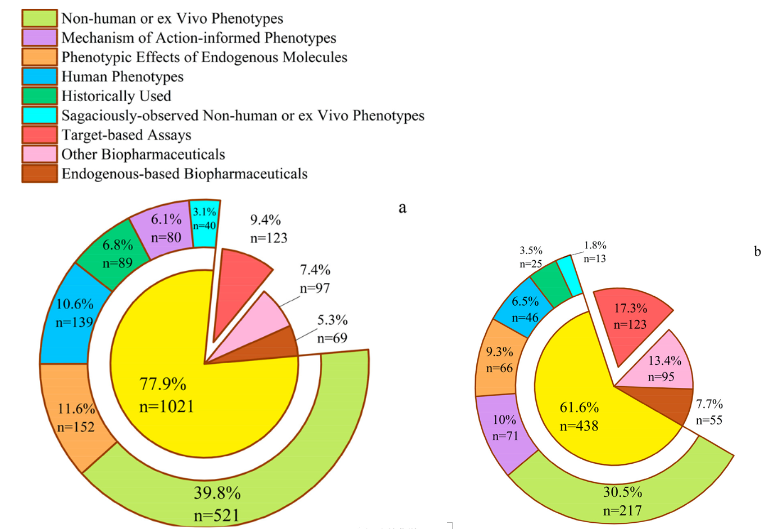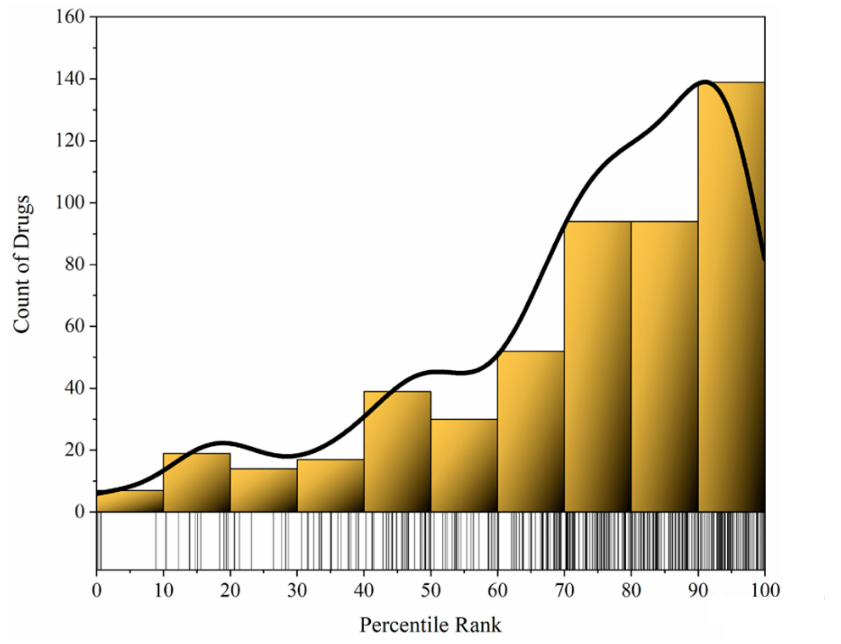Targeted drug discovery: scarce and inefficient, what is the geometry of its effectiveness?
Sandra Forbes
Product Manager

Although target-based drug discovery is currently the dominant approach to drug discovery and development, the latest comprehensive assessment shows that its results are not as good as they could be. The number of drugs discovered by this approach is relatively small, and their therapeutic effects rely heavily on off-target mechanisms. This raises questions about the approach: is it really as effective as we'd hoped? Or is it just a "gold leaf" with a fancy appearance but limited value in reality? In this paper, Arash Sadri's research will provide an in-depth discussion of the efficiency of target-based drug discovery and its relationship with off-target mechanisms.
Challenges and dilemmas behind drug discovery
A review of the literature over the past 150 years reveals that only about 9.4% of small molecule drugs have been discovered through target-based assays. While the ratio of approved drug candidates to those entering clinical studies is about 13%, it is as low as 0.4% in the more complex areas of central nervous system diseases and cancer. In addition, new drug discovery is plagued by inefficiencies, high costs, and the retreat of pharmaceutical companies.
To address these issues, the researchers point out that the current mainstream target-based drug discovery approach has a clear reductionist bias. This approach is overly focused on finding drugs that modulate a single or a few proteins, while ignoring the complex network structures and their feedback mechanisms both inside and outside the cell. The prevalence of this approach has been going on for decades, coinciding with the decline in drug discovery productivity. Therefore, we need to revisit and improve existing drug discovery strategies to meet the current challenges.
Inefficiencies in targeted drug development: reflections on the current situation and future challenges
Although target-based drug discovery methods have been in the limelight, their efficiency and effectiveness have been controversial. Against this background, researchers have proposed a bold hypothesis that the decline in drug discovery efficiency may be related to an over-reliance on target-based reductionist drug discovery methods. This approach focuses on the binding of drugs to a small number of predefined "target" proteins as the basis for molecule selection and optimization, with in vivo and human data typically considered only at the final stage.
To test this hypothesis, the researchers conducted a manual, exhaustive survey of all drugs approved by the US FDA before the end of 2020, focusing on information about the origins of drug discovery. To ensure the objectivity and accuracy of the study, they proposed the following key definitions:
- "Discovery origin": the moment when a correlation between a therapeutic class and a therapeutic effect is first observed.
- "Therapeutic class": refers to a group of substances with chemical or pharmacological similarities associated with a lead molecule.
- "Target-based drugs": refers to drugs whose discovery process is largely dependent on observing the effect of a molecule on a protein.
- "Phenotype-based drugs": refers to those drugs whose discovery process relies primarily on observing the effect of a molecule on the phenotype of an organism.
Through in-depth investigation and analysis, they found that, unlike the traditional target-based drug discovery approach, the traditional approach is more empirical. This approach relies on the therapeutic effects of molecules on humans and other organisms (e.g., animals, fungi, and bacteria) to select and optimize molecules because it lacks the tools to assess the effects of drugs on single proteins. In order to draw more comprehensive and accurate conclusions, the researchers decided to further expand the scope of the study to cover all approved drugs and to enhance the precision and objectivity of the analysis.
New pathways for phenotypic drugs: beyond "targeted" mechanisms, exploring "untargeted" alternatives
In contrast to the target-centered approach to drug discovery, the "off-target" mechanism focuses more on the complex interactions between drugs and multiple proteins. While target-based reductionist drug discovery is still dominant today, this anti-reductionist, evidence-based approach may show greater potential for improving the overall efficiency of drug discovery. With the help of advanced tools such as artificial intelligence and machine learning, we can prioritize higher-level phenotypic observations that are closer to the actual treatment response of patients. The advantage of this approach is that it can more comprehensively consider the various mechanisms of action of a drug and avoid over-focusing on a single target, thus providing a more comprehensive and integrated approach to drug development.
Research data show that phenotype-based drugs account for a significant proportion of all approved drugs. The discovery of these drugs mainly stems from observations of non-human or in vitro phenotypes, observations of human phenotypes, observations of phenotypic effects of endogenous molecules, and phenotypic observations inspired by historically used compounds and mechanisms of action. This suggests that phenotype-based drug discovery approaches have an irreplaceable and important role in drug discovery and that they are not limited to the modulation of single proteins.
When comparing the proportions of phenotype-based and target-based drugs in the total number of approved drugs and in the number of drugs approved after 1995, it is interesting to note that 1995, the year of approval of the first "target-based" drug, saquinnavir, has become the most important year for both types of drugs. The year 1995, when the first "target-based" drug, saquinnavir (S126514), was approved, was an important watershed in the development of these two approaches.

Figure 1. Percentage of different methods in the origin of drug discovery. (a) All approved drugs; (b) drugs approved after 1995.
Although the share of targeted drug development in the number of approved drugs has been increasing year by year, it has never surpassed the share of phenotypic drug development. In fact, many of the so-called "targeted" drugs exhibit a variety of "non-targeted" therapeutic mechanisms. Doneppezil (D332795), for example, was originally developed as an acetylcholinesterase inhibitor, but subsequent studies have revealed up to 40 separate therapeutic mechanisms, including anti-inflammatory, immunomodulatory, and neuroprotective functions.
In addition, we have observed that many of the approved drugs do not have a strong affinity for their therapeutic "targets", but most of them tend to be in the high affinity percentile. This implies that there is a correlation between binding to a high affinity "target" and therapeutic efficacy. However, high affinity binding to a single "therapeutic target" is only one of many factors that influence the therapeutic effect of a drug.

Figure 2. percentile rank of affinity of approved drugs relative to their therapeutic targets for all ChEMBL ligands.
Overall, the target-based approach to drug development may oversimplify the complexity of biological systems. In contrast, high-level phenotype-observing drugs offer a more effective approach to studying and treating disease because they directly target therapeutic effects and are more predictive. This approach treats the complexity of the human body as a "black box" and does not delve into low-level mechanisms, but focuses directly on the ultimate therapeutic effect.
Target-based drug discovery: its non-negligible value and significance
Target-based drug discovery has always played a pivotal role in the long history of drug discovery. Techniques such as computational chemistry, high-throughput screening and combinatorial chemistry were initially highly sought after by the R&D community, but their limitations have gradually surfaced with technological advances and in-depth research. Nonetheless, these technologies remain an essential component of the current drug discovery process.

For specific diseases, such as monogenic Mendelian diseases, the target-based approach to drug discovery and development has fully demonstrated its unique value, which is further validated by the successful cases of monoclonal antibody development. Meanwhile, target-based strategies also play a crucial role in drug discovery and development in the search for analogues, especially in optimizing and improving drug structures. However, in the case of complex diseases, where the collection of advanced data can be costly and cumbersome, a target-based approach can provide a solid building block for research and development.
Nonetheless, there are clear limitations to an approach that relies solely on a single target. To overcome these challenges, researchers have begun to explore the concept of polypharmacology in the hope of enhancing drug efficacy by targeting multiple targets simultaneously. Meanwhile, novel approaches such as systems pharmacology and cyberpharmacology contrast with traditional approaches by taking a holistic view and providing more comprehensive solutions for treating complex diseases that can encompass a wide range of underlying factors of the disease.
Although target-based drug discovery approaches offer significant advantages in some cases, especially when the disease is closely linked to the affinity of specific proteins, future drug discovery still needs to look at the complexity of the disease from a more macroscopic perspective. In order to truly improve the efficiency and efficacy of drug discovery, we must incorporate evidence-based research and fully utilize new technologies and methods to explore the multiple mechanisms of disease. Only then will we be able to bring more comprehensive and innovative solutions to the field of drug discovery and development.
Summary
Overall, target-based drug discovery remains at the core of the drug discovery field. However, future R&D trends will focus more on integrating multiple technologies and approaches to look at drug discovery from a more holistic and predictive perspective. Combined with advances in modern technology, we need to develop a more comprehensive and in-depth understanding of disease to better meet the needs of public health and the challenges facing the pharmaceutical industry. This shift will drive the field of drug discovery and development to make a greater contribution to human health.
Aladdin’s website: https://www.aladdinsci.com/
